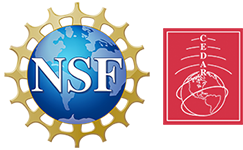2025 Workshop: New Perspectives on Whole-Atmosphere Coupling and MIT System Impacts
Federico Gasperini
Jens Oberheide
Scott Thaller
Dong Lin
Scott England
Shun-Rong Zhang
Laila Andersson
Goodwin Lindsay
Dogacan Ozturk
Joe Huba
Coupling across atmospheric layers is a fundamental driver of variability in the Magnetosphere-Ionosphere-Thermosphere (MIT) system, shaping both space weather and long-term upper atmospheric trends. The MIT system is highly responsive to external drivers, including variations in solar irradiance, solar wind-interplanetary coupling, as well as internal fluctuations from the lower atmosphere. Sudden Stratospheric Warmings are well-established drivers of upper atmospheric variability, but growing evidence shows that other episodic disturbances—including volcanic eruptions and tropospheric convection—can also generate large-scale effects, influencing plasma outflows, neutral-plasma interactions, and storm-time responses. More broadly, lower atmospheric variability—including tides, gravity waves, planetary waves, Kelvin waves, and other disturbances—can modulate plasma transport, ionospheric structuring, and even magnetospheric electrodynamics. Superimposed on these terrestrial-induced variations are abrupt disturbances triggered by solar flares and geomagnetic perturbations in the form of particle precipitation, plasma outflow, field-aligned currents, heat flux, etc. The CEDAR and GEM communities are uniquely positioned to collaboratively study this whole-atmosphere coupling and its impacts on the MIT system. This session welcomes observational, theoretical, and modeling studies that investigate MIT coupling across spatial and temporal scales, with emphasis on new insights from multi-instrument satellite missions (e.g., ICON, GOLD, COSMIC-2, MMS, THEMIS, Van Allen Probes), ground-based networks, and state-of-the-art models (e.g., WACCM-X, MAGE, TIEGCM, SAMI3). Contributions addressing the roles of atmospheric waves and geomagnetic activity in space weather, energy transfer mechanisms, electrodynamic feedback, and interhemispheric asymmetries are particularly encouraged. The theme of this session closely aligns with the NSF/ANSWERS solicitation to support collaborative research on space physics.
Zoom Link: https://clemson.zoom.us/j/8111381902
Meeting ID: 811 138 1902
One tap mobile
+13092053325,,8111381902# US
+13126266799,,8111381902# US (Chicago)
10:00-10:02 Opening Remarks
10:02-10:12 Sharon Vadas: Higher-Order Gravity Waves and TIDs from the Polar Vortex Jet and Comparisons with Equatorial Plasma Bubbles
10:12-10:22 Sevag Derghazarian: Connections Between Stratospheric GWs, the Polar Vortex, and MSTIDs from Longitudinally Distinct Regions
10:22-10:32 Scott England: A Survey of Atmospheric Gravity Waves Observed by GOLD during Quiet to Moderate Solar & Geomagnetic Activity
10:32-10:42 Haonan Wu: TIEGCM Simulation of TIDs/TADs Generated by ULF Waves
10:42-10:52 Ruoxi Li: Thermospheric and Ionospheric Responses to the 2022 Tonga Eruption: Insights from Secondary Gravity Waves and Lamb Waves
10:52-11:02 Ruth Lieberman: Two-Day Wave Modulation of Gravity Wave Momentum Fluxes Observed over South America
11:02-11:12 Katrina Bossert: Influences of the Quasi-Two-Day Wave on Plasma Bubble Behavior over South America
11:12-11:22 Shanshan Bao: Formation of the Bubble-Like Ionospheric Super-Depletion Structure (BLISS): MAGE Simulation of the September 2017 Storm
11:22-11:32 Jun Liang: Cross-Sections of Relativistic Electron Impact and Coupling Between TREx-ATM and WACCM for the D-Region Ionosphere
11:32-11:42 Yunbo Liu: Impact of Lower Atmospheric Forcing on the Interhemispheric Asymmetry of the Equatorial Ionization Anomaly in the American Sector: A Case Study of the September 2020 Equinox
11:42-11:52 Toshi Nishimura: Mid-Latitude Density Irregularities and Scintillation during Storms and Quiet Times
11:52-12:00 Discussion
Understanding the variability of the Ionosphere-Thermosphere-Magnetosphere system and its driving forces has a critical implication on low-earth orbiting (LEO) spacecraft operations, satellite industries, aviation radiation, and communications. Fundamental studies of ITM variability drivers will ultimately lead to enhanced predictability of ITM space weather. Physical processes forced from lower-atmosphere activities transport energy and momentum upward via atmospheric waves, while energy deposition via particle precipitation, field-aligned current, and heat flux, add another layer of fierce source. The confluence of energy and momentum in the ITM involves complex cross-scale and cross-boundary dynamical processes, which remains a compelling scientific question. The respective contributions from the lower-atmosphere and space to the variability of ITM have been investigated, while their collective impacts, coupling and interactions, were less explored. This joint CEDAR-GEM workshop provides a unique opportunity to transcend the CEDAR and GEM program boundaries in data analysis, observations, and modeling. It fosters interactive discussions on ITM space weather, bringing together scientists focused on lower-atmosphere forcing with experts specializing in space origins.
This workshop directly addresses two major space weather themes outlined in the new Heliophysics Decadal Survey: 1) System of Systems: Drivers of Space Weather and 2) Space Weather Responses of the Physical System. It closely aligns with the strategic thrusts of the NSF/CEDAR program: 1) Encourage and undertake a systems perspective of geospace to understand global connectivities and causal relationships; 2) Explore exchange processes at boundaries and transitions in geospace to understand the transformation and exchange; and 3) Fuse the knowledge base across disciplines in the geosciences. In addition, by involving modeling expertise, this workshop supports the goal of the GEM program to advance fundamental research towards the construction of a global geospace general circulation (GGCM) model with predictive capability.
GEM Focus Group:
Magnetospheric Sources of Particle Precipitation and Their Role on Electrodynamic Coupling of Magnetosphere-Ionosphere-Thermosphere Systems (2022 - 2026)
Group leader: Dogacan Su Ozturk, Dong Lin
Magnetospheric Sources of Particle Precipitation and Their Role on Electrodynamic Coupling of Magnetosphere-Ionosphere-Thermosphere Systems (2022 - 2026)
